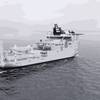Worldwide, the road to success in the ship and boatbuilding market is literally paved with companies that have gone belly up, been acquired or are currently hanging by a literal thread. Many factors -- from too many booms and busts, to foreign shipbuilding subsidies, to political power plays - have conspired to make the business of building boats and ships increasingly difficult.
But in the end analysis, the process of building vessels remains an industrialized manufacturing process, and the companies that have survived and prospered are the ones that have invested in the latest technologies to make the process more efficient.
First Operations Shop, Second to None
Improved steel processing - from cutting through parts marking to final installation - more so than ever determine a yard's marketability, efficiency and profitability. Bender Shipbuilding in Mobile, Ala., is currently in the final phases of integrating one of the most advanced, potentially efficient materials handling facilities in North America, an investment the yards believes will help ensure its position and prosperity well into the next century.
Bender Shipbuilding's transformation from a so-called "second tier" shipyard into a world-class facility is hinged on the success of its newly opened First Operations Shop. The new facility, which features the installation of a high powered laser cutting machine, will include operations such as raw plate and profile receipt and storage, blasting and primer painting plate and profiles, plate cutting, part forming, profile cutting and forming, part identification, part kitting, and delivery of kitted parts to downstream processes. Prior to the First Operations Shop, Bender had no in-house plate cutting capability. In selecting the laser system, Bender has effectively positioned itself to prosper for many years to come. Bender can attribute part of the success of opening the new shop with its collaborations with Caterpillar, which though a Maritech project, provided Bender with a full set of technical data that was key in ascertaining Bender's needs in terms of quality and speed.
In addition, Caterpillar transferred a proprietary technology of tab & slot and twist tab joining designs to Bender Shipbuilding, a technology which is enabled by the precision and cut quality of the laser. Bender calls the technology a significant enhancement to the way in which ships are designed and built, and the concept was presented to ABS for strength and fatigue tests. The results were successful, and now Bender will petition ABS to formally approve the joint design and allow its use in selected applications.
To investigate which cutting solution would be best for Bender, executives embarked on an international tour of yards in Europe and Asia, as well as ship and boatyards in the U.S., such as Bath Iron Works, Friede Goldman, Alabama Shipyard, Avondale, Halter Pascagoula, Halter Equitable and Bollinger.Bender's First Operations Shop -scheduled to open with full functionality at the beginning of 2000 - represents the latest advances in materials processing, as well as laser cutting. According to the company, the 6 kW laser system to be installed offers many quality advantages, including accuracy within .004-in.
In addition, part repeatability is nearly 100 percent, and there is no degradation of the beam quality over the course of the cutting program between normal, routine maintenance. The laser will reportedly be the first large production laser installed in a shipyard in the U.S.
Advances in cutting systems in general, and laser cutting systems in particular, made the task of choosing the correct system for Bender all the more challenging. However, based on significant field research, it was determined that recent advances incorporated into the laser system, in conjunction with the systems amazing accuracy and cutting "cleanliness," helped to make the decision an easy one.
In particular, the development of large gantry laser machines - versus the type of laser cutting system which required the cutting bed be physically moved under the cutter - and the increase of power made the system an obvious choice for Bender. Bender officials found lasers can now be used to produce the highest quality cuts at speeds comparable to plasma in plates up to .75-in. thick, and at slower speeds can provide a superior quality cut on plates up to 1.25-in. thick.
In addition, laser plate cutting maximizes the use of CAD/CAM design integration, helping to eliminate time-consuming plate positioning, manual layout, manual measurement, errors, expensive scrap and re-work.
The First Operations Ship production rate drives the schedule of all subsequent processes. The part identification system, material kitting and staging methods and Just-In-Time delivery of parts determine the amount of material handling required by the end users of the product.
In a paper presented at the 1999 Ship Production Symposium, Bender executives noted in many similar shipyards, First Operations are often a haphazard process, with the same processes occurring in many different parts of the yard, and little, if any, automation incorporated.
Along with the implementation of the First Operations Shop, Bender has incorporated many other procedural and logistical changes which will position it to maximize efficiencies in the future, including the implementation of group technology, the installation and implementation of 3-D product modeling, the development of method planning for new construction, the installation of a state of the art technology information network system, and the establishment of a cycle schedule rather than the critical path scheduling.
Bender clearly states, without Caterpillar's contribution, the First Operations Ship at Bender would likely never have happened. From the outset, Caterpillar presented their view of manufacturing.
Steiner Steps Up
Steiner Shipyard, with origins as a family shipyard dating back to the 1920s, is certainly a well-known and regarded entity in the local maritime markets. However, Steiner is far more than a local player, as it counts companies around the globe, including Japan, as good customers in standing.Steiner is perhaps best known for its endeavors in the fishing vessel markets, as it has built hundreds of boats over the years. But the company's activities are broadly stretched, a strategy, which has yielded dividends as cyclical trends on occasion touch one or more of the branches. The latest business opportunity for Steiner revolves around a new company dubbed Enviro-Metals.
Featuring a Wheelabrator metal processing unit, used to preblast millscale (the coating on metals that must be removed before the metal can be painted), the unit is housed in its own building, which is a great benefit toward complying with EPA guidelines. In fact, Russell Steiner says, the Alabama Conservation Department has even issued tickets if sand goes into the water during the blasting process - a far more likely result for yards still blasting in open air.
The tighter regulations on blasting and coating mean small boatyards need to employ such a process; however, the prohibitive cost of the unit makes the prospect a bit unfeasible. Therefore, Steiner's hope is to offer the company's services to local, smaller shipyards."We'll do it all," Russell says, "we'll cut, blast, prepare the metal. All the shipyard will have to do is assemble the hull."
Steiner is no stranger to such an arrangement, as the company already subs out some expertise work of its own. With only 100 manufacturing employees, such tasks as electrical work, carpentry, refrigeration and electronics are among the jobs subbed out to local businesses.
Sponsored Content
Safer Starts Here: Build Ships, Protect Crews

July 2025
 Read the Magazine
Read the Magazine

 Read the Magazine
Read the Magazine
This issue sponsored by:

Cracking the Code to Predict Underwater Radiated Noise
Subscribe for
Maritime Reporter E-News
Maritime Reporter E-News is the maritime industry's largest circulation and most authoritative ENews Service, delivered to your Email five times per week









